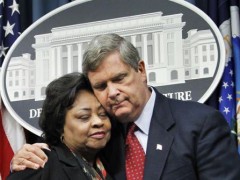WASHINGTON — A 2010 email from Agriculture Secretary Tom Vilsack says his department was “waiting for the go-ahead” from the White House before accepting the resignation of employee Shirley Sherrod, according to newly released documents, despite Obama administration assertions that her ouster was Vilsack’s decision alone.
The email, which was made public Friday in an ongoing federal court case over the matter, shed more light on the evening of July 19, 2010, when the USDA hastily asked Sherrod to resign after a video showing her making supposed racist remarks surfaced on a conservative website. Her dismissal turned into a racial firestorm after it became clear that the video had been edited and her remarks were meant to tell a story of reconciliation.
Both the White House and Vilsack have repeatedly said the agriculture secretary made the decision to ask for Sherrod’s resignation without White House input. The emails, along with earlier emails obtained by The Associated Press under the Freedom of Information Act in 2010 and 2012, make it apparent that Vilsack wanted Sherrod to leave the department and ordered her resignation. But a newly-released email sent by Vilsack himself suggests he was awaiting a decision from White House officials on how to proceed.
“She has offered her resignation which is appropriate,” reads an email from the initials “TJV” to Dallas Tonsager, then the USDA undersecretary of rural development and Sherrod’s boss. “The WH is involved and we are waiting for the go-ahead to accept her resignation. I suspect some direction from WH soon.”
The USDA would not comment on the email and a spokesman, when asked, did not dispute that Vilsack wrote it. The email, sent at 5:37 p.m. on July 19, is in reply to an earlier email from Tonsager addressed to “Mr. Secretary.” Vilsack’s middle name is James.
The correspondence is evidence in a federal defamation case that Sherrod filed in 2011 against the late blogger Andrew Breitbart, who posted the video, and his colleague Larry O’Connor. The Justice Department has been pushing to keep the emails sealed, but lost Friday afternoon when U.S. District Judge Richard J. Leon ruled they did not have to be kept private.
Vilsack’s email was brought up at a court status hearing earlier last week. According to a transcript, a lawyer for Breitbart’s wife, who was substituted as defendant after the blogger died unexpectedly in 2012, said the email was “extremely telling” and “contains a statement that is arguably inconsistent with the public statements.”
Justice Department lawyer David Glass replied to the judge that “when there is a reference to the White House was involved, what it means is the White House liaison was involved.”
USDA’s White House liaison, Kevin Washo, was in touch with the White House through the night, according to the documents. In another newly released email, a White House aide writes to Valerie Green of the White House presidential personnel office, saying “USDA is looking for direction — can someone contact Washo?” Green replies that she is “reaching out now.”
Green writes Washo asking him to loop her in, “Please. Please. Please.”
The department that night accepted Sherrod’s resignation as a USDA rural development official in Georgia. When her full speech came to light the next day, it became clear that Sherrod, who is Black, was speaking about overcoming her initial reluctance to help a white farmer decades ago.
As the administration came under fire, Vilsack reversed course, apologizing and asking her to return to the department — an offer she declined. President Barack Obama also offered Sherrod an apology.
White House officials acknowledged weeks later they had been more involved than they initially let on and had stayed in close touch with USDA that night. They still maintained, however, that the decision to seek Sherrod’s resignation was Vilsack’s alone.
The newly released emails also reveal for the first time missives between White House officials that night. By law, members of the public and the press cannot request internal White House documents directly from the White House.
In one email, then-White House Director of Presidential Personnel Nancy Hogan writes to other White House officials that Sherrod has offered to resign and says they will “need to determine what we say about resignation.”
After the full video came out the next day, frustrated White House officials vented to one another through emails. Senior adviser Valerie Jarrett wrote then-White House Press Secretary Robert Gibbs that “I would not have fired her for it. We just don’t need any of it.”
“Agreed,” Gibbs replied.
In another e-mail to Gibbs that next day, Jarrett notes that then NAACP President Ben Jealous had apologized for condemning Sherrod before knowing the whole story. “We need to do the same and this will do (sic) away. Even Fox said we railroaded Shirley.” In another copy of the same email released by the court, Jarrett’s same words are redacted, citing a FOIA exemption for “deliberative process.”
Lawyers for Breitbart colleague O’Connor filed the emails in court to bolster their argument that government decisions were the reason for Sherrod’s dismissal, not the blog post. The emails show that the officials were made aware there might be a longer video, and that they were concerned about political fallout from her comments. O’Connor’s lawyers argue that the “deliberative process” exemptions prove their point.
“The government cannot assert a privilege to shield the production of decision-making communications, while simultaneously claiming to have had no role in a decision,” the lawyers wrote in their filing.




